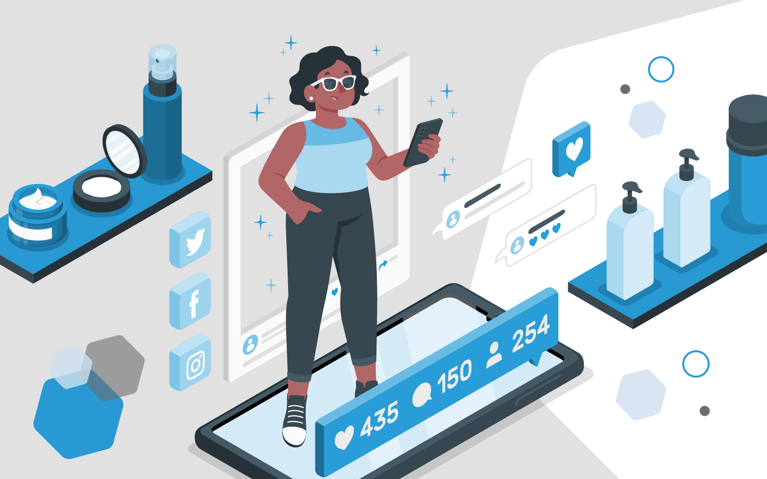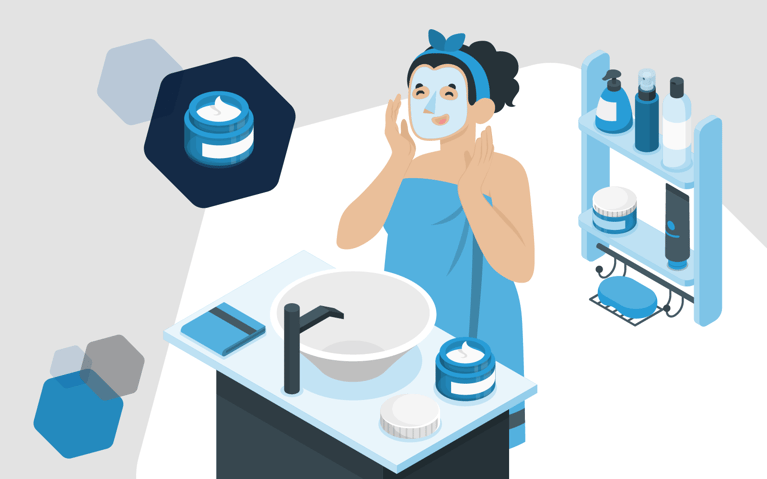The beauty market is already a $646 billion industry – and according to projections, it’s set to hit $736 billion by 2028. Moreover, beauty is growing as fast or faster than apparel, footwear, eyewear and pet care markets. The industry’s growth is attractive and has drawn new companies and investors, increasing competition. However, while the beauty market offers ample opportunity, beauty brands must differentiate through innovation, product, marketing and the customer experience in order to succeed.
The beauty market defined
The beauty market spans cosmetics and personal care, including skin care, hair care, personal care, fragrances, beauty tech and makeup products. The beauty industry is dynamic due to constantly evolving trends driven by social media influence and consumer preferences for innovative products, inclusive representation and an elevated experience. Rapid advancements in technology and ingredients also contribute to frequent product launches and improvements. More recently, the industry's responsiveness to sustainability and ethical practices keeps it in a state of continuous transformation.
Why beauty brands need an exceptional customer experience
Beauty brands must provide an exceptional customer experience to differentiate themselves in a highly competitive market. Each part of the customer journey should be carefully curated through end-to-end strategies that start with creating a powerful marketing strategy and covers optimizing beauty fulfillment operations and inspiring post-purchase loyalty. With rapidly changing trends and a plethora of options available, customers are likely to choose brands that offer personalized, convenient and engaging interactions. Exceptional customer experience fosters brand loyalty, encouraging repeat purchases and positive word-of-mouth referrals. Moreover, it enhances the brand’s reputation and builds trust, particularly when brands are transparent and responsive to customer needs. In an age where customers expect seamless omnichannel experiences, providing consistent and superior service across all touchpoints is crucial for retaining and attracting new customers. This leads to a superior customer experience that can drive higher sales and long-term business growth.
Here are seven strategies from discovery to delivery that help beauty brands create an optimal experience:
1. Personalized marketing
Creating a superior customer experience in the beauty industry requires strategies that resonate with individual needs and preferences. One effective approach is personalized marketing. By leveraging data-driven insights, beauty brands can tailor marketing messages and product recommendations to match individual customer preferences and behaviors. For instance, a skincare brand might use purchase history and browsing patterns to suggest products that address specific skin concerns, enhancing relevance and engagement. This builds a stronger connection with customers and increases the likelihood of repeat purchases. Other personalization strategies include engaging customers through customized email campaigns, exclusive offers and targeted social media ads based on their unique preferences and shopping behaviors. Beauty brands can utilize personalized content, such as tailored beauty tips and tutorials, to create a more immersive and relevant experience for each customer.
2. Omnichannel presence
An omnichannel presence is essential for beauty brands aiming to provide an excellent customer experience. By integrating online, mobile and in-store shopping experiences, brands can ensure that their customers receive consistent service and branding across all touchpoints. For example, a customer might discover a product on Instagram, check its reviews on the brand’s website and then purchase it in-store. This seamless journey enhances convenience and trust. Beauty giants like Sephora excel in this area by allowing customers to book in-store consultations online, access their purchase history via mobile apps and pick up orders curbside or in-store. By providing a cohesive experience, brands can cater to the modern consumer’s preference for flexibility and consistency.
3. Interactive digital engagement and experiential in-store interactions
Engaging customers interactively, both online and in-store, is a game-changer for beauty brands. Experiences like virtual try-ons, live chats and augmented reality (AR) tools can elevate online shopping. Brands like L'Oréal Paris use AR technology to allow customers to virtually try on makeup products before purchasing.
In-store, experiential interactions such as personalized skincare consultations or makeup tutorials can create memorable experiences. These interactive elements not only make shopping more enjoyable but also help customers make informed decisions. By blending cutting-edge digital tools with hands-on, personalized in-store services, beauty brands can create a holistic and engaging customer experience.
4. Loyalty programs and exceptional customer service
Loyalty programs and exceptional customer service are crucial strategies for beauty brands looking to build long-term customer relationships. Rewarding repeat purchases with exclusive discounts, early access to new products and personalized offers can significantly increase customer retention. For instance, the Ulta Beauty Rewards program allows customers to earn points on every purchase, which can be redeemed for discounts.
In addition, responsive and helpful customer support, whether through live chat, email or in-store assistance, ensures that customers feel valued and supported. Hassle-free return policies and post-purchase follow-ups further enhance the customer experience, making them more likely to return and recommend the brand to others.
5. Seamless post-purchase experiences and swift beauty fulfillment
Providing a seamless post-purchase experience is crucial for maintaining customer satisfaction and loyalty in the beauty industry, and it all starts with optimized beauty fulfillment operations. Your hair care, skin care or cosmetic fulfillment operations should keep customers informed with timely notifications about their order status and offer fast delivery and an array of options, such as buy online pick up in-store (BOPIS), to significantly enhance their experience. For example, offering same-day or next-day delivery is critical for customers who need last-minute beauty products. Subscription services, like those offered by Birchbox, can provide regular and convenient access to favorite products. Another layer to add to beauty fulfillment and the post-purchase experience is a thoughtful unboxing experience. Unboxing offers aesthetically pleasing packaging and small personalized touches like sample products or discounts that create a memorable, favorable impression. Beauty brands can turn a single transaction into a lasting relationship by prioritizing efficient fulfillment and an engaging post-purchase journey.
6. Sustainability and transparency
In today’s market, sustainability and transparency are not just buzzwords but essential components of a beauty brand’s strategy. Emphasizing eco-friendly practices, such as recyclable packaging and ethical sourcing, can significantly enhance a brand's appeal to environmentally conscious consumers. Brands like Lush are known for their commitment to sustainable practices, using natural ingredients and transparent communication about their sourcing and manufacturing processes. Clear labeling of product ingredients and providing detailed information about the brand's environmental impact help build trust with consumers. By being open and honest, beauty brands can foster a loyal customer base that values ethical and sustainable practices.
7. Community building
Building a strong community around a beauty brand can drive engagement and foster a sense of belonging among customers. Leveraging social media platforms and partnering with influencers can help create a vibrant community where customers feel connected to the brand. Encouraging user-generated content, such as reviews, testimonials, and social media posts, can enhance authenticity and trust. For instance, Glossier's success is largely attributed to its active and engaged community of users who share their experiences and recommendations online. Hosting live Q&A sessions, tutorials and virtual events can further strengthen these connections. By creating a space where customers can share and connect, beauty brands can cultivate a loyal and enthusiastic customer base.
Cart.com for your end-to-end beauty strategy
Ready to elevate your beauty brand? Our growth marketing services are designed to boost your reach and engagement, while our optimized omnichannel beauty fulfillment solutions and services ensure swift and seamless deliveries. Contact our team of experts today to learn how we can help you achieve unified commerce and take your brand to the next level, delighting your customers every step of the way.
Subscribe to our emails for the latest industry insights!
By entering your email, you agree to receive marketing emails from Cart.com








